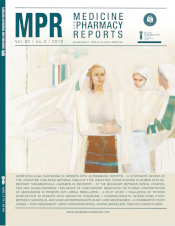Glycated albumin is correlated with glycated hemoglobin in type 2 diabetes
DOI:
https://doi.org/10.15386/mpr-1247Keywords:
glycated serum albumin, glycated hemoglobin, type 2 diabetes mellitusAbstract
Background and aims. Glycated hemoglobin (HbA1c) retrospectively evaluates mean glycemia in the preceding 2-3 months and is the gold standard for assessing glycemic control, while glycated albumin (GA) is currently considered a short to intermediate term integrated glycemic control marker, since it reflects glycemic status over the last 3 weeks. We aimed to investigate the levels of GA, HbA1c and fasting glycemia in a group of patients with type 2 diabetes.
Methods. The observational study included adult type 2 diabetes patients (n=135) according to inclusion and exclusion criteria, randomly selected from Clinical Centre of Diabetes, Cluj-Napoca, Romania. Fasting glycemia, GA, HbA1c and creatinine were measured using commercially available methods.
Results. Of the whole group, 62 (45.9 %) were men. Mean age was 62.1±8.6 years old, body mass index was 31.8±6.1 kg/m2 and diabetes duration was 10.0 (4.0; 15.0) years. Fasting glycemia was 162±13.7 mg/dl, GA was 28.0 (21.0; 40.0)% and HbA1c 8.9±2.3%. We found GA was significantly correlated with HbA1c (r=0.19; p=0.029) and fasting glycemia (r=0.32; p<0.001), while HbA1c was significantly correlated with fasting glycemia (r=0.40; p<0.001).
Conclusions. GA was significantly correlated with both HbA1c and fasting glycemia in our patients with type 2 diabetes. While HbA1c is recognized as being the reference test for diabetes control monitoring, GA might a useful biomarker for assessing short to intermediate term glycemic control, particularly important in situations when HbA1c test cannot be reliable or earlier clinical decision making is mandatory.
Downloads
Published
How to Cite
Issue
Section
License
The authors are required to transfer the copyright of the published paper to the journal. This is done by agreeing to sign the Copyright Assignment Form. Whenever the case, authors are also required to send permissions to reproduce material (such as illustrations) from the copyright holder.

The papers published in the journal are licensed under a Creative Commons Attribution-NonCommercial-NoDerivatives 4.0 International License.

